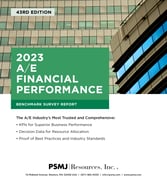By most accounts, architecture and engineering (A/E) firms are delivering some of their best financial performance in years…some are even seeing their firm’s best performance of all time. Profits are high, backlogs are strong, and there isn’t a whole lot that is slowing things down right now.
PSMJ’s 2023 A/E Financial Performance Benchmark Survey Report shows a record-breaking median operating profit margin on net revenue of 20.1% (compared to a value of 18.3% in the previous report). This may all sound like great news.
And, it is…but also isn’t.
Even if you shattered your firm’s profit margin records this year, if you are below that median value, you are (by basic definition) in the bottom half of the pack. In fact, even if you are close to that median on either side doesn’t help you to stand out when it comes to selling your firm in a merger or acquisition, ensuring a sustainable internal ownership transition program, or providing sufficient funds to out-invest your competition in marketing, technology, and building the best team.
So, what do you do next if you want to blow past 20.1% profit margins? Benchmark!
Benchmarking: What Is it… and Why It’s SO Important
Let’s take an example. When we look at profit margins, it just isn’t enough to stop and wonder why yours may be below the benchmark value. Two metrics that drive profit are the firm’s utilization rate and direct labor multiplier. Unfortunately, too many firm leaders narrowly focus on achieving a high utilization rate…period. The reality is that utilization might not have as much of an impact on profitability as you think.
One reason you shouldn’t focus too much on the labor utilization rate (on a total dollar basis) is that the business environment has changed dramatically over the years due to digital transformation. So the hours of direct billable labor from time spent drawing and drafting have decreased significantly, while overhead costs associated with managing technology have increased.
There’s still a positive correlation between labor utilization rates and profitability, but it’s variable between 12-14% from year to year.
Your firm’s profitability largely boils down to a function of these three Key Performance Indicators (KPIs):
• Direct Labor Multiplier
• Labor Utilization Rate
• Non-Labor Overhead Expense
To illustrate the importance of digging deep to diagnose cause and effect, consider the example of a civil/survey firm with 63 employees serving the commercial development industry. This firm delivered the following KPIs:
• Direct Labor Multiplier: 2.8
• Labor Utilization Rate: 62%
• Operating Profit Margin on Net Revenue: 6%
Now, this is where it is critical to check each of these indicators against peer benchmarks for size, market, and industry. Of course, this firm’s profit margin is well below the industry median. What is interesting in this example is that the direct labor multiplier is well below average while the labor utilization rate is actually above average.
Without detailed benchmarking, executives in this example firm may not see that they really need to focus on their direct labor multiplier to boost profits. Further, equipped with the understanding that they are underperforming in profitability due to a below-average direct labor multiplier, they should compare targets versus achieved multipliers to determine whether the root cause is pricing or project management.
Beyond the Basics: Track the Right Key Performance Indicators
Improving your overall performance with benchmarking requires that you invest in identifying and tracking the right key performance indicators. At PSMJ, we use the following KPIs to award our Circle of Excellence designation to top-performing firms in our survey data set:
• Net Direct Labor Multiplier (Achieved)
• Operating Profit (As a % of Net Revenue)
• Operating Profit (Per Total Staff)
• Staff Size Change
• Return on Overhead
• Labor Utilization Rate (Payroll Dollars)
• Operating Overhead Rate (Before Bonus and/or Distributions)
• Accounts Receivable Collection Rate (Days of Gross Revenue)
• Net Revenue Backlog (As a % of Net Revenue)
• Return on Working Capital
• Gross Revenue Growth Rate
• Staff Turnover Rate
• Net Revenue (Per Total Staff)
The first step in benchmarking is to establish your baseline. Good or bad, you need to know where you are now so that you can set realistic goals to boost specific KPIs. This may also mean aligning your income statement and balance sheet accounts to be apples-to-apples with the survey data set on these metrics.
High Quality Decisions Start with High Quality Data
Another common mistake in A/E benchmarking? Using lousy benchmark data. When you compare your firm’s performance to an industry standard, it’s absolutely critical that your benchmark data be rock-solid. Your strategic investments in growth and long-term success absolutely depend on this. Here are 13 questions to see if you are using the right benchmark data for your A/E firm:
1. Is the data from a reputable industry-specific source?
2. Is the data broken down into the right peer groups?
3. Is the data sample size sufficient for benchmarking?
4. Is the data vetted for erroneous or “junk” data?
5. Is the data available in an easy-to-use tool format to save you time and money?
6. Does the data dig deep beyond simple “vanity” metrics?
7. Does the data provide accrual-basis and cash-basis benchmarks?
8. Does the data provide historical trends on key metrics?
9. Does the data include FAR-basis metrics for government contractors?
10. Was the data collected using best-in-class methodologies for accuracy?
11. Was the data collected within the past 12 months?
12. Can the publisher articulate which metrics truly drive high performance?
13. Can the publisher provide long-term historical data to support litigation?
Only PSMJ’s 2023 A/E Financial Performance Benchmark Survey Report can provide you with a confident and resounding ‘YES” to each and every one of these questions! Get your copy of the report or the easy-to-use Excel-based model to confidently ensure that your firm is achieving its full profit potential!



